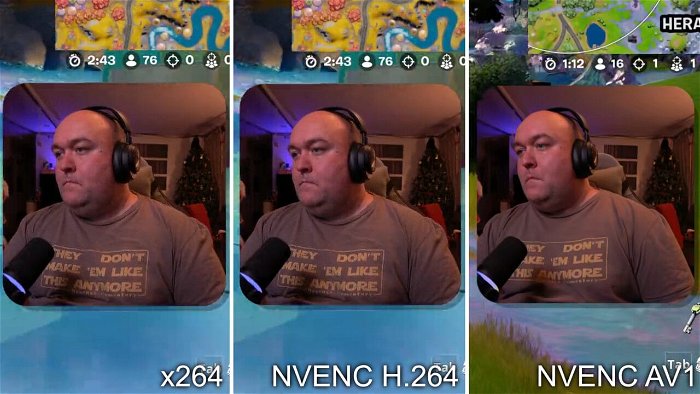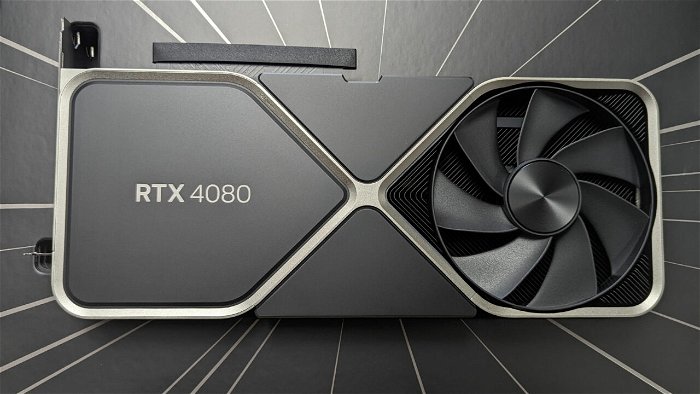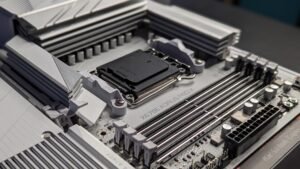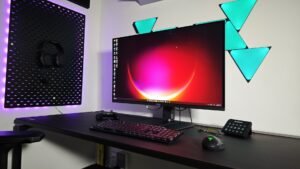The NVIDIA GeForce RTX 4080 Founders Edition GPU is an astonishing offering, delivering amazing 4K performance, but that power does come at a cost. It has taken a while to arrive, but the next generation of NVIDIA GPUs is here, and they are showing what is possible when a company goes all out in terms of performance and power. Boasting impressive specs and dominating benchmarks, the GeForce RTX 4080 GPU is a testament to NVIDIA’s efforts, but the price tag and requirements could keep it from being a card everyone should buy.
The GeForce RTX 4080 GPU Build & Design
With the potential power under the hood of the NVIDIA GeForce RTX 4080 Founders Edition GPU, it is easy to get hyperbolic about just how much an evolution the card is compared to the 30 series. The RTX 30 series was already pretty great, from the low end all the way up to the massive, power-hungry RTX 3090 family. The RTX 4080 is something else entirely, giving a taste of what 4K and 8K gaming could actually feel like.
Looking under the hood, the RTX 4080 is a robust offering, with 9,728 CUDA cores, 304 fourth-gen Tensor cores, and 76 third-gen RT cores. However, it includes a boost clock speed of 2,505MHz, compared to the RTX 3080 Ti’s 1,665MHz clock. Additionally, the RTX 4080 has 16GB of GDDR6X VRAM, compared to 12GB on its 30-series counterpart.
The new generation of GPUs is like nothing we’ve seen before. With promises of more power and better performance, the RTX 4080 is set to change the game. For years, we’ve been talking about ray tracing and 4K gaming, and finally, we have a GPU that can deliver on those promises. With its new architecture, NVIDIA’s RTX 4080 Founders Edition GPU is a genuinely monumental leap forward.

Much like the NVIDIA GeForce RTX 4090, the RTX 4080 is a giant among graphics cards. Even in its Founders Edition form, this is a GPU that will dominate the case it is in and is honestly one of the heaviest and most expensive graphics cards you can currently buy, and that is not even talking about the 3rd party editions of the card that are sure to dwarf what you can find here.
As many people saw with the release of the NVIDIA GeForce RTX 4090, the RTX 4080 may be a problem for some people looking to make the leap. It takes up three PCIe slots in a case, and depending on your motherboard layout, you may lose the use of PCIe x16 slots or even be unable to fit the card in due to heatsink placement. On our ASUS ROG Maximus Z690 Hero board, for example, with the RTX 4080 trying to fit into the top PCIe slot, it ran into the problem of the M.2 SSD heatsink interfering with the card, making it unable to fit.
We thankfully managed to find a test bench motherboard that allowed the RTX 4080 to fit without any issues, and thanks to the be quiet! Dark Base 900 full tower, we had the needed space to have everything in place and running properly. But even with this all in place, there are a few other factors to consider. The RTX 4080 requires using a 16-pin to 4 x 8-pin adapter cable to provide power and should not run the card with less than a 750W PSU. This means it is even more cables to manage, and you will need a case deep enough to fit everything without running into problems.

In all honesty, the RTX 4080 Founders Edition PCB is far smaller than the GPU would let on. The size and weight are thanks to the large heatsink and fans that keep the card cool even under load. The card is basically one big piece of metal with fans at opposing ends and on opposing sides of the card to help with airflow. Thankfully, you should not worry about the card bending over time due to its solid build, even without a stabilizer. However, it would still be recommended not to put unnecessary strain on the PCIe port.
Looking at the IO on the new card, the RTX 4080 is a little behind the times when it comes to display outputs. While it does have HDMI 2.1, it doesn’t have DisplayPort 2.0. With more 8K displays slowly hitting the market, while this may not be a big deal right now, it does limit the RTX 4080’s potential going forward. With both Intel Arc and the new Radeon RX 7900 Series boasting the latest DisplayPort, this oversight could leave NVIDIA struggling with the newer displays, although time will tell on this front.
“The performance makes the NVIDIA GeForce RTX 4080 GPU a powerful tool for gamers…”
Even without looking at the benchmarks, it is clear the NVIDIA GeForce RTX 4080 Founders Edition GPU is in a class all its own. It is built to deliver the latest in gaming and software and do so without breaking a sweat. This is a card made to deliver the latest games in 4K, and it does so well. Having said that, it is potentially more than most gamers will really need, and with its $1200 price tag, it could be well out of reach for many people looking just to play the latest games.
Slotting it into our be quiet! Dark Base Pro 900 case with its 13th Gen Intel i9-13900K build with an MSI 850W PSU, 64GB SK Hynix DDR5, and a PCIe Gen 4 2TB Kingston Fury M.2 SSD, the card demonstrated how powerful the latest cards from NVIDIA really are. It consistently outperforms the competition at 1440p and 4K, even when ray tracing is involved. If you’re looking for the best possible mainstream gaming experience, the RTX 4080 is the card you want. While the RTX 4090 may be more powerful, most people will not notice the extra FPS the card will deliver.

RTX 4080 Gaming Benchmarks
The NVIDIA GeForce RTX 4080 Founders Edition GPU managed to stay at the top of our benchmarks in all tests, blowing the RTX 3070 out of the water and making the AMD Radeon RX 6700 and other cards in the range feel antiquated in comparison. Coming out of the gate swinging with a 13,752 in 3D Mark Time Spy extreme benchmark, the RTX 4080 demonstrated the generational gap compared to the RTX 30 series, which was already impressive. Games like Cyberpunk 2077, F1 22, Shadow of the Tomb Raider, Fortnite, Call of Duty: Modern Warfare II, and Hitman 3 all showed impressive results, with ray tracing turned on and across the board in all our benchmarks.
4K Game Benchmarks
| Game | GeForce RTX 4090 | GeForce RTX 4080 | Radeon RX 6900 XT | GeForce RTX 3070 | Radeon RX 6700 XT |
|---|---|---|---|---|---|
| Call of Duty: Modern Warfare 2 | 139 | 119 | 82 | 52 | 51 |
| Forza Horizon 5 | 147 | 121 | 92 | 65 | 56 |
| Shadow of the Tomb Raider | 132 | 127 | 78 | 57 | 64 |
| Cyberpunk 2077 | 85 | 80 | 45 | 32 | 25 |
| Assassin’s Creed Odyssey | 109 | 82 | 63 | 52 | 60 |
| Watch Dogs Legion | 105 | 98 | 60 | 56 | 36 |
| Hitman 3 | 181 | 155 | 101.3 | 61 | 62 |
The GeForce RTX 4080 GPU is a powerhouse that feels wasted on anything less than complex workflows, the latest games or 4K performance. While we have many great monitors in the CGMagazine offices, few could push the pixels needed to take full advantage of what the RTX 4080 could deliver. It is a card that would be overkill for anything less, and with other mid-range cards on the market or coming soon to the market, there are plenty of other options if you don’t plan to make the leap to 4K any time soon.
“The NVIDIA GeForce RTX 4080 Founders Edition GPU managed to stay at the top of our benchmarks in all tests…”
Beyond 4K, the GeForce RTX 4080 GPU can also tackle 8K at speeds and quality that could be worth playing. These displays may be a ways off from a decent price or mass market adoption, but it is great to see that the card could manage it when you make the plunge. It is hard to say how well it will work for all games, but from initial testing, there is plenty of headroom to push the card even into 8K, although this is when DLSS 3 could come into the picture, but more on that later.
1440P Game Benchmarks
| Game | GeForce RTX 4090 | GeForce RTX 4080 | Radeon RX 6900 XT | GeForce RTX 3070 | Radeon RX 6700 XT |
|---|---|---|---|---|---|
| Call of Duty: Modern Warfare 2 | 225 | 159 | 139 | 81 | 86 |
| Forza Horizon 5 | 168 | 154 | 99 | 91 | 78 |
| Shadow of the Tomb Raider | 237 | 178 | 138 | 120 | 127 |
| Cyberpunk 2077 | 145 | 124 | 98 | 65 | 55 |
| Assassin’s Creed Odyssey | 153 | 110 | 91 | 75 | 78 |
| Watch Dogs Legion | 110 | 107 | 104 | 72 | 61 |
| Hitman 3 | 202 | 173 | 162 | 109 | 100.2 |
While I was incredibly impressed with the performance of the RTX 4080, I was even amazed at how well the card fared in thermals and power draw under load. With the card using 320 watts of power and running at a base clock of 2.205 GHz, I was expecting to see the card get much warmer while playing the latest games, but somehow it managed to stay around the 65 degrees Celsius mark.
1080P Game Benchmarks
| Game | GeForce RTX 4090 | GeForce RTX 4080 | Radeon RX 6900 XT | GeForce RTX 3070 | Radeon RX 6700 XT |
|---|---|---|---|---|---|
| Call of Duty: Modern Warfare 2 | 293 | 249 | 209 | 128 | 126 |
| Forza Horizon 5 | 178 | 150 | 130 | 98 | 76 |
| Shadow of the Tomb Raider | 320 | 278 | 223 | 154 | 144 |
| Cyberpunk 2077 | 161 | 140 | 106 | 82 | 74 |
| Assassin’s Creed Odyssey | 288 | 256 | 210 | 156 | 145 |
| Hitman 3 | 419 | 355 | 266 | 212 | 223 |
NVIDIA managed to tame the beast with the massive heatsink and fans, and I would be interested to see how well third-party cards fare in comparison. Thankfully, the thermals are also incredibly quiet, with it never feeling like a jet engine, even when the fans work hard to keep the card cool. A great thing to see, especially for a card with this horsepower.
DLSS 3.0



Beyond the hardware, NVIDIA has been steadily improving their DLSS offering, making it more impressive than ever. For anyone not aware, DLSS (deep learning super sampling) is a family of real-time deep learning image enhancement and upscaling technologies developed by NVIDIA. It is used to help display games at higher resolutions without sacrificing speed, allowing games that may be struggling at 4K or 8K to run at playable framerates.
For most people, the differences between native and DLSS 3.0 will be minimal, and as NVIDIA keeps helping publishers implement the technology in their games, the tech becomes increasingly more exciting. The list of DLSS 3.0 games is still growing but currently includes The Witcher 3, F1 22, and Microsoft Flight Simulator, to name a few.
I was incredibly impressed with what I saw from DLSS 3.0 in testing. While Cyberpunk 2077’s DLSS 3.0 version is still in beta, it already showed striking results. Games like F1 22, A Plague Tale: Requiem, Tower of Fantasy, and Microsoft Flight Simulator showed notable improvements, offering up, at times, up to a 2X boost in frames compared to DLSS off, all without giving a noticeable degradation in quality.
RTX 4080 and Content Creation

Looking at the creation side of things, the 40 series of RTX Graphics Cards are the first in the NVIDIA line to support AV1 encoding, whose compression provides a much more efficient encoding experience. You can now encode video at smaller bit rates while maintaining the same quality as previous NVENC encoding options, H.264 and H.265. This leads to smaller file sizes (your storage thanks you) and shorter upload times. Or you can opt to match your current bit rate and increase the overall quality of your product. AV1 is 40% more efficient at 1080p than H.264 and 30% better than H.265. As you increase your resolution, the efficiency improves by up to 50%.
The RTX 4080 GPU’s dual AV1 encoders offer an even more efficient experience. The encoding engines can work in parallel, divide up a frame, and stitch them back together into one singular output. This method can double your encoding speed compared to the RTX 30 series.

We had the opportunity to test AV1 streaming on a special discord server where it has been enabled (OBS supports AV1 recording but not streaming yet). In addition to streaming my own screens in AV1, we watched a side-by-side comparison of AV1 and H.264, and the difference is significant when you look at them next to each other. Both streams were encoding at 8 MB per second, and the AV1 stream was head and shoulders above the other.
We recorded additional content from OBS using a Facecam as well to see the encoding differences on real-life images. The difference in detail between H.264 and AV1 was just as notable on recorded video as it was on stream. While recording 2160p/60fps video at 8 MB/s playing Fortnite with the highest graphics settings and capturing a 4K camera, we were able to notice the quality jump on AV1 encoding, but also a lightened load on OBS. The average time to render a frame on AV1 was 1.4ms, while it hovered around 2.4ms on H.264. You can read more on AV1 encoding, content creation and the NVIDIA GeForce RTX 4080 GPU here.

Is the RTX 4080 Worth the Investment?
There is a lot to like about the NVIDIA GeForce RTX 4080 GPU. It is a powerhouse when it comes to games and brings much-needed features that make content creation and video work easier and more streamlined than ever before. While the RTX 4090 was overkill for many, the RTX 4080 feels like the sweet spot between performance and price, giving a solid card that is tailor-made for the enthusiast market.
As more people look to jump into the world of content creation, be it for streaming or video creation, the performance and features make the RTX 4080 GPU an amazing offering, one that looks to not only improve the workflow but does so while increasing quality, speed and efficiency.
The performance makes the NVIDIA GeForce RTX 4080 GPU a powerful tool for gamers, ready to deliver 4K games at triple-digit FPS while delivering some of the most realistic lighting, shadow and detail. Combine that with DLSS 3.0, and NVIDIA has a winning formula, making the RTX 4080 ready for the next generation of games and features just waiting to be unlocked.

With all this power comes a problem; much like the RTX 4090, the RTX 4080 still needs a notable upgrade to your PC if you don’t already have a power supply, motherboard or case that can fit the incredibly large card. There is also the question of how well the new AMD Radeon RX 7900 XTX and RX 7900 XT cards will do in comparison, especially considering they will cost less than what NVIDIA has on offer.
Even with these caveats, the RTX 4080 is an impressive graphics card with a hefty price tag, making it a great option for gamers who aren’t concerned about spending an extra buck. It is a major generational leap compared to the RTX 30-series, and as NVIDIA keeps working on software like DLSS 3.0, the real potential of the card is still waiting to be seen. As it stands now, for creators, gamers, and people looking to get the most from their PC, your new mainstream king is here.







